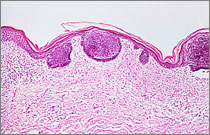Assessment of completeness
- How does the ZfKD assess completeness?
- For which types of cancer is evaluation difficult?
- What are the results of the current completeness assessment?
The value of population-based cancer data vitally depends on the completeness of the capture of all incident cancer cases. The situation in the individual federal states is, however, very heterogeneous in this respect: continuous, state-wide registration commenced between 1967 (Saarland) and 2009 (Baden-Württemberg). The German Centre for Cancer Registry Data (ZfKD) thus regularly estimates the degree of completeness for the population-based cancer registries.
How does the ZfKD assess completeness?
The basis for this evaluation are regional comparisons of the ratio of mortality to incidence (M/I-index), an indicator also used by other cancer registries around the world. Under the assumption that diagnostic and therapeutic practices – and therefore survival prospects of cancer patients – are similar among the federal states, the M/I-index should not vary strongly from region to region.
Using the M/I-index of a reference region comprised of registries with longstanding, good quality data along with cancer mortality data from a region whose completeness is to be assessed, it is possible to estimate the expected cancer incidence in that region and compare it with the number of cases actually reported. Cases registered solely based on death certificate information (DCO cases) are exclude from these calculations. The completeness of the reference registries is also assessed in the same manner.
The following criteria were established for inclusion in the reference region:
- State-wide cancer registration for at least ten years
- Overall completeness during the last ten years over 90 percent on average and over 80 percent for all individual years
- Proportion of DCO cases on average below 15 percent in the last ten years or beginning with the sixth year after the start of registration
These criteria are currently met by the registries in Saarland, Hamburg, Schleswig-Holstein, Lower Saxony, four of seven administrative districts in Bavaria, and the eastern part of North Rhine-Westphalia (Westphalia-Lippe).
According to the principle described above, expected values are calculated by age group, sex and diagnosis group. If regional mortality lies below five deaths per year on average for a particular age group, sex and diagnosis group, then the ratio of incidence to population in the reference region is used instead of the ratio of mortality to incidence when calculating the expected number of new cases. The estimated completeness for each diagnosis group is the ratio of observed to expected case numbers summed up over age groups and sex. The overall completeness of the registry is estimated by summing the observed and expected values for all diagnosis groups.
For which types of cancer is evaluation difficult?
Limitations of the described procedure arise mainly when the mortality from a cancer type is low overall or in relation to its incidence (e.g., testicular cancer, malignant melanoma, thyroid cancer), or when the M/I-index in fact differs between regions. This may be the case, for example, if cancer screening utilization differs by state or, as with mammography screening, is introduced at different times. Regional differences in the distribution of tumor stages or cancer subtypes (e.g. thyroid cancer) can also lead to variation in the M/I-index.
What are the results of the current completeness assessment?
According to the current estimate for the last two available years, ten states achieved an estimated completeness of at least 90 percent, five of which were above 95 percent. Data for 2016 could not yet be provided from the Joint Cancer Registry for the new German states and Berlin, so the estimated completeness here refers to the period 2014/2015. For Bremen, where the processing of notifications from 2015 is still largely pending, the data from 2014 and 2016 were used.

![]() Estimated completeness of the epidemiological cancer registries in Germany 2015/2016, by federal state (in parentheses: start of registration).
Estimated completeness of the epidemiological cancer registries in Germany 2015/2016, by federal state (in parentheses: start of registration).
These weaker results, compared to the previous issue of "Cancer in Germany", can be explained by the nationwide establishment of clinical cancer registration and the associated restructuring of the existing registries. These activities have led to considerable delays in the processing of diagnostic reports in some registries. After the end of this restructuring phase, epidemiological cancer reporting should also benefit from the nationwide expansion of clinical cancer registration. The remaining data gaps for the years 2015 and 2016 are also expected to be largely closed.
Date: 06.11.2020






